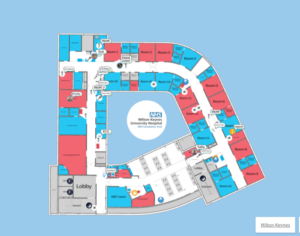Digital Twin
Project Status: Concept Trials

At MKUH, we have been delivering a pilot project within our cancer ward to assess the challenges of the single-room ward environments and look to digital solutions to improve both patient care and staff productivity. The objective was to introduce a solution whereby staff would feel better supported in caring for patients in single rooms and then look at ways in which we could introduce innovative processes and products that created an improved ward environment.
Caring for patients in shared multi-bedded environments are often crowded spaces that can create a stressful rather than tranquil place to work or get better. Milton Keynes University Hospital’s (MKUH) new Cancer Centre was commissioned in 2019 and featured a modern design with a high percentage of single patient rooms, plus several open-plan clinical assessment areas. It’s argued that single patient rooms provide a better patient experience, with privacy and dignity maintained and personalisation of the care environment more feasible. Still, with increasing demands on staff to enter patient information on bulky workstations-on-wheels, and with staffing shortages continuing to affect resourcing, single-room wards can have their challenges, such as unnecessary disturbances when staff enter rooms searching for staff and equipment.
The solution was a digital replica ward using IoT (Internet of Things) sensors and an RTLS (Real Time Locating System). Known as a ‘Digital Twin’, the system collected data about room occupancy, the location of critical medical equipment, and the general movement of people on the ward. The Digital Twin was visualised as an interactive map that could be accessed by computer and smartphone. The results were that clinical staff could view and react to real-time events instantly and without the need to disturb patients. The system has now become a key feature to productivity in the ward.
This trail has identified the concept of a Digital Twin system as highly adaptable and easily transferred to other hospital environments. The Wi-Fi connected senor are small and relatively inexpensive. They are also easy to install with minimal disruptions to staff and patients. We are currently trialling the system in administration spaces to monitor desk use and meeting room bookings, with the objective of using office space in smarter ways and creating a better working environment for staff. With this, we have also recently successfully integrated the technology with our site airflow and heating systems to monitor air quality and temperature, allowing the system to be adjusted as required.
Last Modified: 1:11pm 29/09/2023

